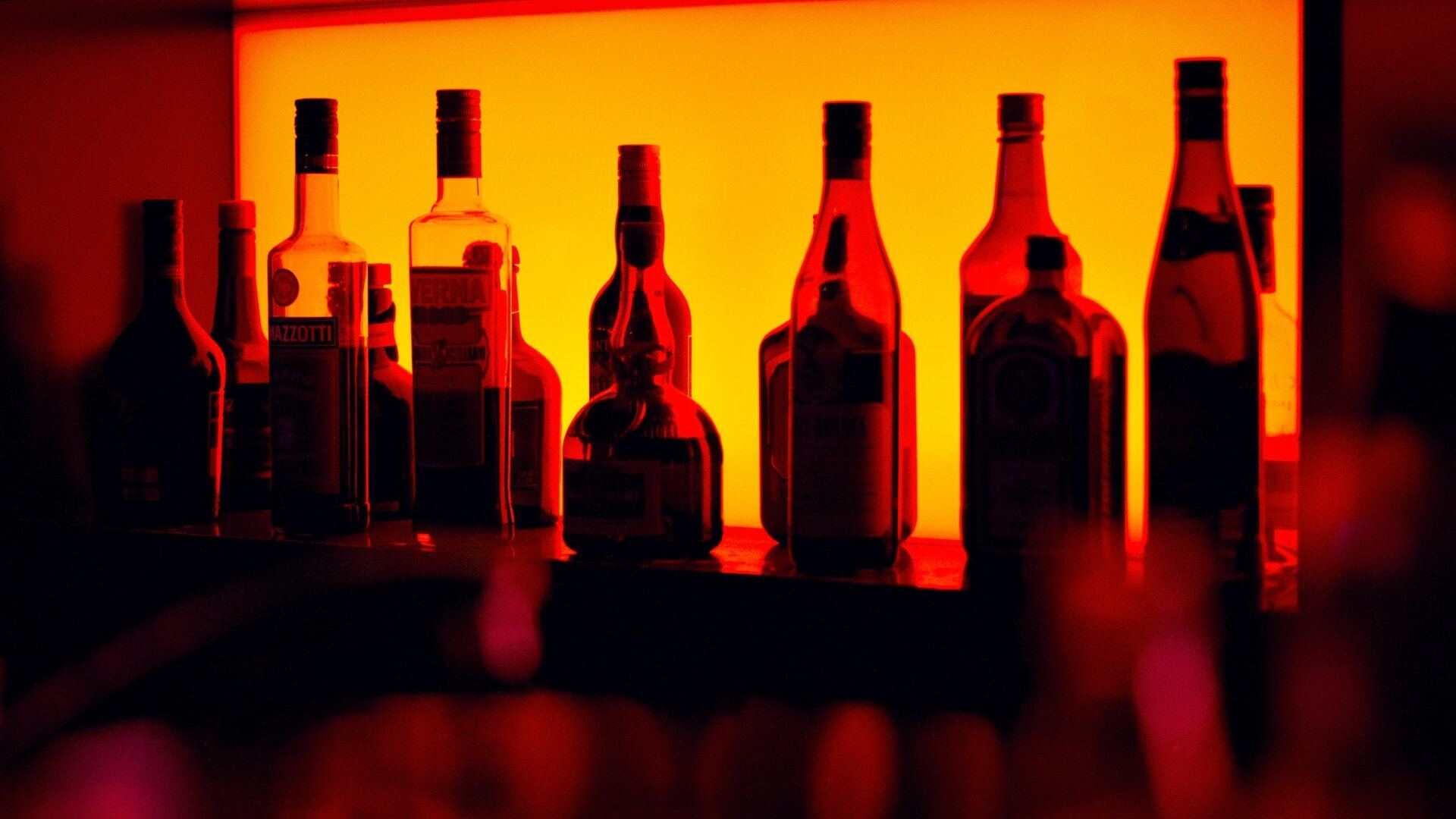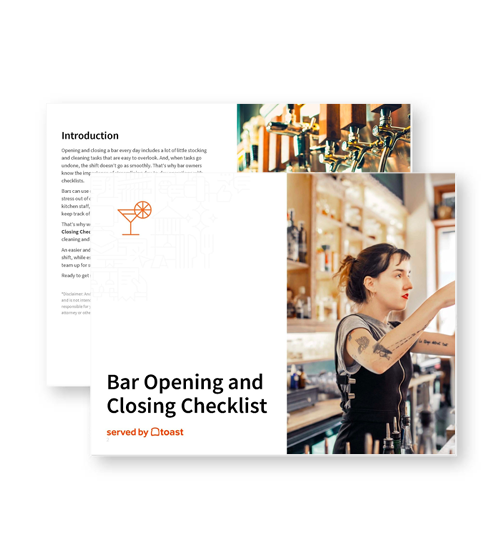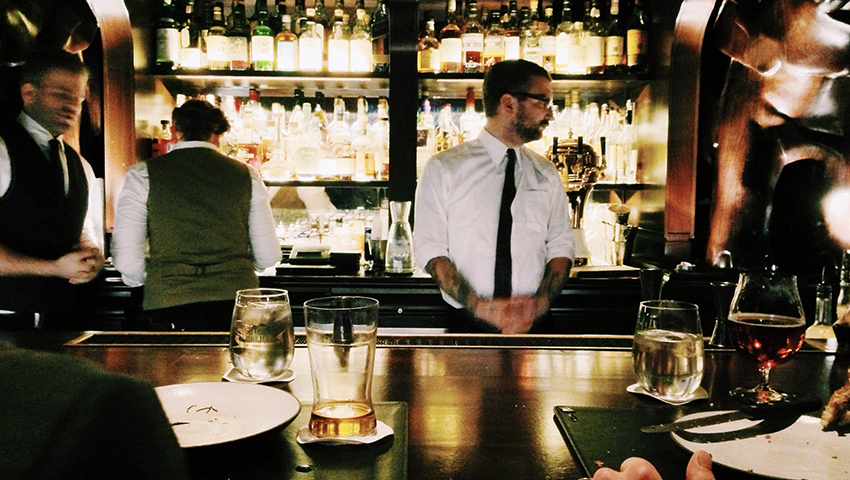
How to Make Opening and Closing Checklists for Bars
Opening and closing checklists for your bar will keep the drinks flowing and help staff to keep up with food safety and alcohol service regulations.
Tyler MartinezAuthor

Bar Opening & Closing Checklist
The beginning and end of a shift can be frantic. Use this free PDF checklist to set your bar staff up for success.
Get Free Download | Built for Restaurants
| Built for RestaurantsWhat is a bar opening and closing checklist?
Opening and closing checklists are lists of the key tasks that staff complete at the start and end of the workday. Opening checklists ensure that the bar is ready to run smoothly throughout the day. Closing checklists help staff to clean the bar properly and set the bar up for the next shift.
Bar Opening and Closing Checklist Guide
Opening and closing a bar every day includes a lot of little stocking and cleaning tasks that are easy to overlook. And, when tasks go undone, the shift doesn’t go as smoothly. That’s why bar owners know the importance of streamlining day-to-day operations with checklists.
Bars can use opening and closing checklists to take some of the stress out of delegating tasks to staff. Bartenders, support staff, kitchen staff, and management all benefit from using checklists to keep track of tasks.
You can create checklists for each area of the restaurant and divide them by the kinds of tasks, such as cleaning and stocking. Make the lists easy for staff to use by listing tasks in the order they should be completed. And, you can create checklists for all those pesky weekly and monthly cleaning tasks that are sometimes overlooked.
In this article, we will teach you how to train your bar’s staff to use opening and closing checklists effectively during every shift. We cover strategies for creating the checklists and provide samples for some of the tasks that can be included in each list.
What is an opening and closing checklist?
Opening and closing checklists collect the key tasks the bar’s staff completes at the start and end of each workday. Opening checklists help to ensure the bar runs smoothly throughout the shift. Closing checklists help the staff remember all the organizing and cleaning tasks that must be done each night to set the bar up for the next day. Managers, bartenders, and support staff can all use checklists to help keep them on task and reduce waste.
Why do you need a checklist before opening and closing a bar?
Countless small tasks go into managing and working for a bar, and even the most seasoned and reliable employees sometimes forget things. Checklists for staff help to keep productivity up by reducing mistakes and setting everyone up for a successful shift. Management can also use checklists to keep the bar running smoothly and securely. Checklists are some of the best tools for maintaining food and alcohol safety regulations, as well.
Easier training
Checklists help to streamline the training process for both new and existing staff. New staff can easily keep track of everything that they need to learn to do using opening and closing checklists. They also help existing staff to adjust to changes in procedures and processes. With checklists, no one has to rely on memory to know what needs to be completed.
Learn how to build (and rebuild) your team with Joy from Busboys and Poets.
Your Guide to: Restaurant Staffing

Team accountability
Checklists simplify delegation and help to ensure that the work is divided fairly between team members. They can also be a way for staff to hold each other accountable for their work. With small or large bartending teams, checklists can save everyone valuable time.
Ensures cleanliness standards
Maintaining a clean and tidy workspace is critical for bartenders to work efficiently and for keeping up with food safety regulations. Checklists help to ensure that all the cleaning tasks, such as burning ice at the end of the night and sanitizing the ice bin, are completed.
Reduces mistakes
Bartenders have some of the fastest-paced positions in the industry. Opening and closing checklists help staff to set themselves and their coworkers up for a successful shift. Forgetting to restock a liquor, popular beer, or mixer can cost valuable time during busy shifts. Checklists can help to reduce common mistakes.
Increases efficiency
Checklists are helpful for training staff, keeping the bar organized, and reducing mistakes which can all increase the efficiency–and profitability–of the business. When cleaning and stocking tasks are completed properly and on time, shifts usually run much smoother. Checklists help to eliminate time-consuming guesswork and make it easier to remember to complete all necessary tasks.
Tips for creating and implementing your bar’s opening and closing checklists
Brainstorm tasks
A great first step toward creating your bar’s opening and closing checklists is brainstorming tasks. Create a list of all the tasks that you can think of. Then, divide the lists by workstation, shift, and type of task. For example, create separate checklists for bartenders and barbacks to communicate the expectations of each role. You might also create a list of cleaning and management tasks that should be completed weekly or monthly.
Consult your team
Your staff has its feet on the ground during every shift. They likely complete tasks that you didn’t think to list in the first draft. Your team can help you to fill out the list and to create a realistic plan for cleaning every surface and hidden corner of the bar.
Use a template
Checklists are easier to use when they’re written with clear and precise language. Templates can help you to communicate clearly when you're writing your bar’s checklists. Templates are available for all areas of the restaurant, and we provide some examples below that can help you get started.
Train the team
While checklists might seem straightforward, it’s important to train your team to use them during every shift. Some team members might feel that they can complete everything from memory. But, checklists work best when they are used consistently. Make several copies of each of the lists and distribute them around the bar. You can even laminate them to protect them from spills and make them reusable with dry-erase markers.
Update often
As your bar’s menu changes and your business grows, you’ll probably need to add and remove items from each of the opening and closing checklists that you create. Each time processes and procedures change, create new checklists and train the staff on the new policy. Make sure that your team is working from the most recent versions of the checklists so that everyone is on the same page.
Types of opening and closing checklists
Creating checklists for each area of the bar helps to delegate tasks to the right staff members. For peak efficiency, list tasks in the order they should be completed and divide the lists by the kind of task. The examples below can help you to start building your bar’s opening and closing checklists.
Bar opening Checklist
Bartenders build drinks, take orders, and serve customers. Support staff such as barbacks often help bartenders to keep the bar stocked with liquor, beer, wine, spirits, mixers, ice, and garnishes throughout the shift. Some bartender and barback opening and closing tasks include:
Wipe down the bar and bar stools.
Set the bar with menus, beverage naps, and straws.
Turn on the point of sale system (POS).
Set up mise en place at the bar.
Fill ice wells.
Set the music, lighting, and temperature.
Bar closing checklist
Empty trash bins and replace bags.
Wipe down the bar and barstools.
Sweep and mop floors.
Clean the soda gun.
Burn extra ice and sanitize ice wells.
Count cash drawer and calculate tips.
Kitchen opening checklist
The kitchen staff at bars might be less pressed for time than at a restaurant. But they are still responsible for maintaining food safety standards and keeping the bar’s kitchen clean and organized. Consider adding these tasks to the kitchen staff’s checklists:
Set up stations with sanitizer buckets and cleaning supplies.
Restock stations for line cooks.
Pre-heat ovens, stoves, fryers, and heaters.
Prep ingredients for the shift.
Identify and report any missing inventory and 86 menu items if necessary
Set up kitchen stations with the right equipment
Check temperatures in all refrigeration units.
Kitchen closing checklist
Clean and sanitize all food preparation equipment and cooking surfaces.
Sweep and mop floors.
Place ingredients in the walk-in cooler.
Make sure food is organized according to food safety standards to prevent cross-contamination.
Clean and sanitize cooking equipment.
Turn off ovens, stoves, fryers, and heaters.
Management opening checklist
Bar managers delegate tasks, solve problems during the shift, and make plans to keep the bar’s staff and guests safe. Here are some tasks you might include on management checklists:
Confirm that cash register drawers include amounts reported from previous shifts.
Review the inventory of alcohol, supplies, and ingredients.
Prepare for a staff meeting.
Walk through the bar to make sure that everything is clean.
Organize incoming deliveries.
Review the staff schedule.
Explain specials to staff and review menu items.
Set daily sales goals.
Management closing checklist
Delegate cleaning tasks to the staff.
Check bartenders’ cash registers.
Review sales and labor costs for the day and run reports.
Walk through the restaurant to check the staff’s closing tasks.
Lock doors and set the security system.
Streamline Opening and Closing with Checklists
Checklists can help opening and closing shifts go down smoother just like the cocktails your bartenders serve. There are dozens of tasks that staff should complete at the beginning and end of each shift and it’s difficult to remember them all. Creating checklists for each area of the bar helps staff to manage tasks. That way, the staff can focus on providing a memorable experience to each guest.
Related Resources
Bar Opening & Closing Checklist
The beginning and end of a shift can be frantic. Use this free PDF checklist to set your bar staff up for success.

Is this article helpful?
DISCLAIMER: This information is provided for general informational purposes only, and publication does not constitute an endorsement. Toast does not warrant the accuracy or completeness of any information, text, graphics, links, or other items contained within this content. Toast does not guarantee you will achieve any specific results if you follow any advice herein. It may be advisable for you to consult with a professional such as a lawyer, accountant, or business advisor for advice specific to your situation.
Read More
Subscribe to On the Line
Sign up to get industry intel, advice, tools, and honest takes from real people tackling their restaurants’ greatest challenges.
By submitting, you agree to receive marketing emails from Toast. We’ll handle your info according to our privacy statement. Additional information for California residents available here


